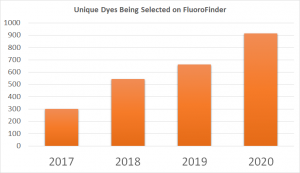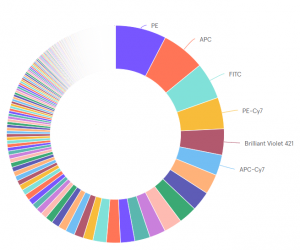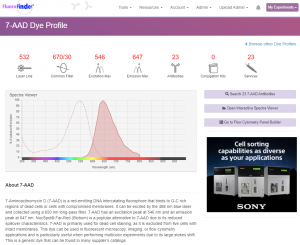Introducing FluoroFinder’s Fluorescent Dye Directory
Innovations in fluorescent dye technology coupled with increased demand for more efficient research tools have resulted in the development of an incredible amount of new fluorescent dye products in recent years. With this multitude of new fluorescent dye products now available to researchers, deciding which is the best dye to use has become more and more challenging.

Breakdown of Dyes Selected on FluoroFinder
To help researchers find the right dyes for their experiments, FluoroFinder is rolling out a new resource to our community: our Fluorescent Dye Directory. We have compiled vital information on hundreds of fluorochromes, fluorescent dye products, and fluorescent proteins into a single Fluorescent Dye Directory to allow researchers to have one place to search for the best fluorescent product for their experiment. Vital information such as excitation and emission profiles, commonly used laser line and filters, photostability, and brightness are outlined all in one resource. Furthermore, the associated products to each dye from multiple suppliers are outlined. Check out one example here, the FITC Fluorescent Dye Profile.
Each dye page is embedded with an interactive Spectra Viewer which allows users to visualize the excitation and emission properties of each dye. FluoroFinder’s Spectra Viewer allows users to add lasers, filters, and multiple other dyes to the same graph to better visualize fluorescent dye compatibility with a user’s specific instrument settings as well as other dyes.
Recent Dye News
With the growing popularity of high parameter flow cytometry, life science companies are rapidly developing new fluorescent products to expand research applications. Some recently launched new dye lines available to them to aid in their experimental design.
Bio-Rad StarBright Dyes
Bio-Rad’s new StarBright line of fluorescent dyes were developed to be very bright, photostable, and easy to use. They are compatible with most staining protocols, any commonly used buffer, can be pre-mixed, and can withstand fixation without loss of signal, making it easy to slot these dyes into any experiment. Although designed for traditional flow cytometry to have narrow excitation and emission peaks, they are also suitable for spectral flow cytometry. In fact, many have unique spectra that can be resolved from other dyes that emit fluorescence at similar peaks when used in spectral flow cytometry. Check out the StarBright dyes on FluoroFinder’s Spectra Viewer, StarBright dye products on FluoroFinder’s Panel Builder, or go to Bio-Rad’s website to learn more.

Bio-Rad’s StarBright Dyes in the FluoroFinder Spectra Viewer
Phitonex NovaFluor Dyes
New from PhitonexTM, are the NovaFluorTM fluorescent dyes. This unique line of dyes consists of 19 labels for the blue (488nm), yellow/green (561nm), and red (640nm) laser lines. State-of-the-art optical engineering using the PhitonTM platform allows for digital brightness and reduced cross-laser excitation and spectral spillover. These properties allow NovaFluorsTM unique spectral signatures to fit into previously unused detectors on spectral cytometers. In addition, NovaFluorTM labels can be used to replace traditional fluorochromes on conventional cytometers, enabling researchers to see more biology by creating larger high-resolution multi-color panels. Currently, NovaFluorsTM are offered as ready-to-use antibody-fluorochrome conjugates as well as being available through conjugation kits. Furthermore, PhitonexTM offers in-house conjugation of NovaFluorsTM to large quantities of the antibody of your choice. Check out the NovaFluorTM fluorescent dyes on FluoroFinder’s Spectra Viewer, the dye products on FluoroFinder’s Panel Builder, or the PhitonexTM website.
While life science companies continue to innovate and rapidly produce new fluorescent products, choosing the right research tools can be difficult. Check out the resources that FluoroFinder has to offer such as the Fluorescent Dye Directory, the flow cytometry Panel Builder, the Spectra Viewer, and more to help find the right tools for your research.






